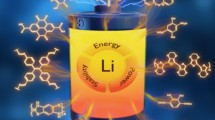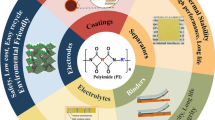Abstract
Flexible, lightweight and high conductivity substrates are required for the development of next-generation flexible Li-ion batteries (LIBs). In addition, the interfacial strength between the active material and flexible substrate should be optimized for high-performance LIBs. Herein, cotton cloth (CC) is employed as a flexible substrate, and electroless plating is utilized to deposit a layer of Cu nanoparticles, which enhances the conductivity of CC and acts as a precursor for the active material, i.e., CuO. The results reveal that the in situ etching and subsequent heat treatment converted Cu film into CuO nanowires on CC substrate. Moreover, carbon nanotubes (CNTs) are introduced to enhance the connectivity of CuO nanowires. Consequently, the CuO/CNT/CC electrode rendered a high areal capacity of > 700 μAh·cm−2 after 100 charge/discharge cycles as well as excellent rate capability. The current work presents a novel route to develop desirable substrates for next-generation flexible Li-ion batteries.






Similar content being viewed by others
References
Liu C, Li F, Ma LP, Cheng HM. Advanced materials for energy storage. Adv Mater. 2010;22(8):E28.
Song WJ, Lee S, Song G, Park S. Stretchable aqueous batteries: progress and prospects. ACS Energy Lett. 2019;4(1):177.
Zhang Q, Xu W, Sun J, Pan Z, Zhao J, Wang X. Constructing ultrahigh-capacity zinc–nickel–cobalt oxide@Ni(OH)2 core–shell nanowire arrays for high-performance coaxial fiber-shaped asymmetric supercapacitors. Nano Lett. 2017;17(12):7552.
Zhou Z, Zhang Q, Sun J, He B, Guo J, Li Q, Li C, Xie L. Metal–organic framework derived spindle-like carbon incorporated α-Fe2O3 grown on carbon nanotube fiber as anodes for high-performance wearable asymmetric supercapacitors. ACS Nano. 2018;12(9):9333.
Zeng W, Shu L, Li Q, Chen S. Fiber-based wearable electronics: a review of materials, fabrication, devices, and applications. Adv Mater. 2014;26(31):5310.
Zhu YH, Yang XY, Liu T, Zhang XB. Flexible 1D batteries: recent progress and prospects. Adv Mater. 2019;32(5):1901961.
Wu ZP, Liu KX, Lv C, Zhong S, Wang Q, Liu T, Liu X, Yin L. Ultrahigh-energy density lithium-ion cable battery based on the carbon-nanotube woven macrofilms. Small. 2018;14(22):e1800414.
Liu W, Song MS, Kong B, Cui Y. Flexible and stretchable energy storage: recent advances and future perspectives. Adv Mater. 2017;29(1):1603436.
Yuan S, Huang XL, Ma DL, Wang H, Meng F. Engraving copper foil to give large-scale binder-free porous CuO arrays for a high-performance sodium-ion battery anode. Adv Mater. 2014;26(14):2273.
Yuan S, Chen W, Zhang L, Ji Z, Zheng Y, Wang Q. Self-supported Bi2MoO6 nanosheet arrays as advanced integrated electrodes for Li-ion batteries with super high capacity and long cycle life. NANO. 2018;13(6):1850066.
Huang XL, Xu D, Yuan S, Ma D, Wang S. Dendritic Ni–P-coated melamine foam for a lightweight, low-cost, and amphipathic three-dimensional current collector for binder-free electrodes. Adv Mater. 2014;26(42):7264.
Weng W, Sun Q, Zhang Y, He S, Wu Q. A gum-like lithium-ion battery based on a novel arched structure. Adv Mater. 2015;27(8):1363.
Weng W, Sun Q, Zhang Y, Lin H, Ren J, Lu X. Winding aligned carbon nanotube composite yarns into coaxial fiber full batteries with high performances. Nano Lett. 2014;14(6):3432.
Liang Y, Zhao J, Han J, Yu H. Application of lithium rare metal in rechargeable batteries. Chin J Rare Met. 2019;43(11):1187.
Lin Z, Xia Q, Wang W, Li W, Chou S. Recent research progresses in ether-and ester-based electrolytes for sodium-ion batteries. InfoMat. 2019;1(3):376.
Wang Z, Malti A, Ouyang L, Tu D, Tian W, Wågberg L, Hamedi MM. Copper-plated paper for high-performance lithium-ion batteries. Small. 2018;14(48):1803313.
Park BK, Kim D, Jeong S, Moon J, Kim JS. Thin solid films, direct writing of copper conductive patterns by ink-jet printing. Thin Solid Films. 2007;515(19):7706.
Lee Y, Choi J, Lee KJ, Stott NE, Kim D. Large-scale synthesis of copper nanoparticles by chemically controlled reduction for applications of inkjet-printed electronics. Nanotechnology. 2008;19(41):415604.
Chen X, Zhong C, Liu B, Liu Z, Bi X, Zhao N, Han XP, Deng YD, Lu J, Hu WB. Atomic layer Co3O4 nanosheets: the key to knittable Zn–air batteries. Small. 2018;14(43):e1702987.
Mohamed HSH, Wu L, Li CF, Hu ZY. In situ growing mesoporous CuO/O-doped g-C3N4 nanospheres for highly enhanced lithium storage. ACS Appl Mater Interface. 2019;11(36):32957.
Cao KZ, Liu H, Li W, Han Q, Zhang Z, Huang K, Jiang Q. CuO nanoplates for high-performance potassium-ion batteries. Small. 2019;15(36):1901775.
Liu YF, Xiong L, Li P, Hu F, Hou Z, Zhu L, Li W. Self-supported CuO nanoflake arrays on nanoporous Cu substrate as high-performance negative-electrodes for lithium-ion batteries. J Power Sources. 2019;428(15):20.
Li Y, Zhang M, Qian J, Ma Y, Li Y, Li W. Freestanding N-doped carbon coated CuO array anode for lithium-ion and sodium-ion batteries. Energy Technol. 2019;7(7):1900252.
Jia S, Wang Y, Liu X, Zhao S, Zhao W, Huang Y, Li Z. Hierarchically porous CuO nano-labyrinths as binder-free anodes for long-life and high-rate lithium ion batteries. Nano Energy. 2019;59:229.
Chen W, Zhang H, Ma Z, Li S, Li Z. Binder free Cu(OH)2/CuO electrodes fabricated directly on copper foils by facile large-scale production method. J Alloy Compd. 2018;762(25):565.
Niaz NA, Hussain F, Khalil RMA. Hybrid nanocomposites of multi-walled carbon nanotubes (MWCNTs) and CuO as electrode materials for energy storage devices. J Electron Mater. 2020;49(2):1096.
Dong Y, Jiang X, Mo J, Zhou Y, Zhou J. Hollow CuO nanoparticles in carbon microspheres prepared from cellulose–cuprammonium solution as anode materials for Li-ion batteries. Chem Eng J. 2020;381:122614.
Han X, Guo X, Xu M, Pang H, Ma Y. Clean utilization of palm kernel shell: sustainable and naturally heteroatom-doped porous activated carbon for lithium–sulfur batteries. Rare Met. 2020. https://doi.org/10.1007/s12598-020-01439-9.
Li Y, Guo X, Zhang ST, Pang H. Promoting performance of lithium–sulfur battery via in situ sulfur reduced graphite oxide coating. Rare Met. 2020. https://doi.org/10.1007/s12598-020-01498-y.
Yu C, Yang K, Yu JC, Cao F, Li X, Zhou X. Fast fabrication of Co3O4 and CuO/BiVO4 composite photocatalysts with high crystallinity and enhanced photocatalytic activity via ultrasound irradiation. J Alloy Compd. 2016;509(13):4547.
Shalan AE, Oshikiri T, Narra S, Elshanawany M, Wu HP, Nakamura K, Shi X, Diau E, Misawa H. Cobalt oxide (CoOx) as an efficient hole-extracting layer for high-performance inverted planar perovskite solar cells. ACS Appl Mater Interfaces. 2016;8(49):33592.
Ma Y, Jia Y, Lin Y, Shi W. Hierarchical Ag/Bi2MoO6 hollow nanoboxes with high photocatalytic performance. Dalton Trans. 2019;48(32):12009.
Yuan S, Chen W, Zhang L, Liu Z, Liu J, Liu T, Li G. Nitrogen-doped graphene-buffered Mn2O3 nanocomposite anodes for fast charging and high discharge capacity lithium-ion batteries. Small. 2019;15(50):1903311.
Hu L, Pasta M, Mantia FL, Cui LF, Jeong S. Stretchable, porous, and conductive energy textiles. Nano Lett. 2010;10(2):708.
Wang H, Song Y, Li YW, Wang MW, Ma QL, Yu WS, Li D, Dong XT, Wang JX, Liu GX. Rationally designed hierarchical porous CNFs/Co3O4 nanofiber-based anode for realizing high lithium ion storage. RSC Adv. 2018;8:30794.
Tan Y, Jia Z, Sun J, Wang Y, Cui Z. Controllable synthesis of hollow copper oxide encapsulated into N-doped carbon nanosheets as high-stability anodes for lithium-ion batteries. J Mater Chem A. 2017;5(46):24139.
Yuan S, Zhao Y, Chen W, Zhang L, Wang Q. Hierarchical SnO2 nanosheets array as ultralong-life integrated anode for lithium-ion batteries. NANO. 2017;12(6):1750077.
Xue X, Yuan S, Xing L, Chen ZH. Porous Co3O4 nanoneedle arrays growing directly on copper foils and their ultrafast charging/discharging as lithium-ion battery anodes. Chem Commun. 2011;47(16):4718.
Jiang C, Ye Z, Ye H, Zou Z. Li4Ti5O12@carbon cloth composite with improved mass loading achieved by a hierarchical polypyrrole interlayer assisted hydrothermal process for robust free-standing sodium storage. Appl Surf Sci. 2020;504:144464.
Li Y, Jiang T, Yang H, Lei D, Deng X, Hao C, Zhang F. A heterostructured Co3S4/MnS nanotube array as a catalytic sulfur host for lithium–sulfur batteries. Electrochim Acta. 2020;330:135311.
Li X, Zhu P, Li Q, Xu Y, Zhao Y, Pang H. Nitrogen-, phosphorus-doped carbon–carbon nanotube CoP dodecahedra by controlling zinc content for high-performance electrocatalytic oxygen evolution. Rare Met. 2020;39(6):680.
Xue X, Deng P, Yuan S, Nie Y, He B, Xing L, Zhang Y. CuO/PVDF nanocomposite anode for a piezo-driven self-charging lithium battery. Energy Environ Sci. 2013;6(9):2615.
Seo S, Jin Y, Lee S, Shim H, Kim D. Low-temperature synthesis of CuO-interlaced nanodiscs for lithium ion battery electrodes. Nanoscale Res Lett. 2011;6:397.
Acknowledgements
This study was financially supported by the National Natural Science Foundation of China (Nos. 21701022 and 51690161), the Fundamental Research Funds for the Central Universities (Nos. N182505037 and N182410001), the Young Elite Scientists Sponsorship Program by CAST (No. 2018QNRC001), the Liao Ning Revitalization Talents Program (No. XLYC1807214) and the National Training Program of Innovation and Entrepreneurship for Undergraduates (No. 201910145260).
Author information
Authors and Affiliations
Corresponding author
Electronic supplementary material
Below is the link to the electronic supplementary material.
Rights and permissions
About this article
Cite this article
Shi, M., Wu, S., Han, ZD. et al. Utilization of electroless plating to prepare Cu-coated cotton cloth electrode for flexible Li-ion batteries. Rare Met. 40, 400–408 (2021). https://doi.org/10.1007/s12598-020-01582-3
Received:
Revised:
Accepted:
Published:
Issue Date:
DOI: https://doi.org/10.1007/s12598-020-01582-3




